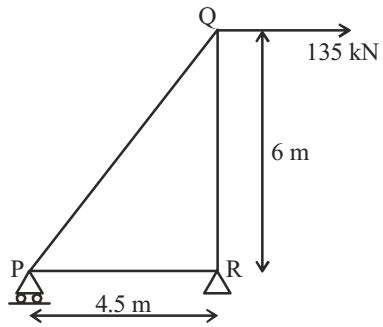Mechanical and structural analysis miscellaneous
- The maximum tensile stress at the section X-X shown in the figure below is

-
View Hint View Answer Discuss in Forum

= 6P bd
Max tensile stress= 2P + 6P = 8P bd bd bd Correct Option: A

= 6P bd
Max tensile stress= 2P + 6P = 8P bd bd bd
- The maximum shear stress in a solid shaft of circular cross-section having diameter subjected to a torque T is t. If the torque is increased by four times and the diameter of the shaft is increased by two times, the maximum shear stress in the shaft will be
-
View Hint View Answer Discuss in Forum
τ = T r J τ1 T.d/2 J = π d4 J 32 = Td/2 π d4 32 τ2 = 4T × 2d/2 π (2d)4 32 = 4Td π 16d4 32 ∴ τ2 = 1 τ1 2 ∴ τ2 = τ 2 Correct Option: C
τ = T r J τ1 T.d/2 J = π d4 J 32 = Td/2 π d4 32 τ2 = 4T × 2d/2 π (2d)4 32 = 4Td π 16d4 32 ∴ τ2 = 1 τ1 2 ∴ τ2 = τ 2
- The degree of static indeterminacy of the rigid frame having two internal hinges as shown in the figure below, is

-
View Hint View Answer Discuss in Forum
Degree of static indeterminacy
= no. of external forces + no. of internal reaction – 3 – no. of internal hinges
= 4 + 2 × 3 – 3 – 2 = 5Correct Option: D
Degree of static indeterminacy
= no. of external forces + no. of internal reaction – 3 – no. of internal hinges
= 4 + 2 × 3 – 3 – 2 = 5
- A rigid bar GH of length L is supported by a hinge and a spring of stiffness K as shown in the figure below. The buckling load, PCT for the bar will be

-
View Hint View Answer Discuss in Forum
Moment at G = 0 (hinge)
At collapse, moment at G
PCr × δ = k - δ × L
∴ PCr = k .LCorrect Option: C
Moment at G = 0 (hinge)
At collapse, moment at G
PCr × δ = k - δ × L
∴ PCr = k .L
- The right triangular truss is made of members having equal cross sectional area of 1550 mm2 and Young’s modulus of 2 × 105 MPa. The horizontal deflection of the joint Q is

-
View Hint View Answer Discuss in Forum
∑MR
= 0 135 × 6 = Vp × 4.5
∴ Vp = 180 kN (↓)
∴ VR = 180 kN ↑ (for balancing)
At P,
FPQ = 180 kN
θ = tan-1 (6/ 4.5)
= 53.13°
∴ FPQ = 225kN Fak = 180kNδH = ∑P.L AE = 1000 1550 × 2 × 105 
(Dividing by 125 to get force in each member for 1 kN force)
we get, δH =15.68 mmCorrect Option: D
∑MR
= 0 135 × 6 = Vp × 4.5
∴ Vp = 180 kN (↓)
∴ VR = 180 kN ↑ (for balancing)
At P,
FPQ = 180 kN
θ = tan-1 (6/ 4.5)
= 53.13°
∴ FPQ = 225kN Fak = 180kNδH = ∑P.L AE = 1000 1550 × 2 × 105 
(Dividing by 125 to get force in each member for 1 kN force)
we get, δH =15.68 mm

